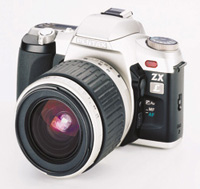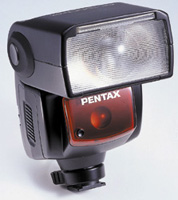New Pentax ZL And AF360FGZ Flash
A Compact 35 And Expanded Flash Controls
Like many manufacturers, Pentax is constantly striving to upgrade their SLR cameras. At this year's PMA show, Pentax released the new ZX-L, called MZ-6 in other countries. This mid-range model benefits from some of the technology developed for the MZ-S, their flagship SLR camera, particularly the highly versatile and advanced flash metering system. Add the latest AF360FGZ flash unit and you gain a wealth of sophisticated capabilities, discussed later. Of course, this is a full-featured camera on its own, surprisingly well equipped for an affordable model. It replaces the ZX-5N and retains most of that model's advanced functions while gaining others. I managed to get one of the first samples of the ZX-L and found it highly responsive while shooting images of people, places, and events. Controls And Characteristics
|
|||
A large selector dial allows even the novice to begin using this camera without reading the Owners Manual; any of 13 features can be selected with this single dial. Some other cameras use a similar control, but this one has an advantage. Whenever any Program mode is selected, the pertinent symbol on the dial is illuminated, which is very useful in low light. Yes, there are a few buttons, too, but all are extremely well marked with logical symbols and most are ideally located, where a finger or thumb comes to rest. Although there is a control dial for Program shift and for setting shutter speeds, the apertures are selected with the lens ring in Manual and Aperture Priority mode. This is a slower process but continues a Pentax tradition, appreciated by conservative photographers. If the flash mode is set to "Auto," the built-in TTL flash pops up automatically when needed in Program modes. In bright light, the head can be manually raised to produce fill flash. Evaluation For shooting my first test rolls, I referred to the instructions only for specifics about the 11 custom functions. The most useful of these include: film leader left out after rewind, continuous AF in Sports Program, autoexposure bracketing increment, and spot meter selection. Naturally, I spent an hour studying the AF360FGZ flash Owners Manual because of its many uncommon flash capabilities. With this flash unit, the affordable ZX-L is competitive with the more expensive Pentax MZ-S in many shooting situations.
|
|||
Autofocus System The ZX-L includes the most important AF options and it proved to be quick and reliable in producing sharp focus. The three focus points do not cover a very large area of the frame, but that is not a problem in people and travel photography. Action photographers will prefer the MZ-S, with its more advanced SAFOX VII system. That model also has six focus detection points, useful in sports or bird photography when a subject drifts further from the center of the frame. Neither camera provides a signal as to which focus point is active. With a static subject, do check the viewing screen to ensure that the most important subject is in sharp focus or switch to the single central sensor. Like many affordable SLRs, the ZX-L is also missing a control for selecting continuous predictive auto-focus. That feature is automatically activated when subject motion is detected, but all such systems are a bit slow to switch to the Follow-Focus mode. When I wanted to photograph a moving tram, the first few frames of the sequence were not sharp. Setting the custom function for full-time continuous AF in Sports Program solved that problem. As long as the subject's speed was moderate and consistent, the system had no difficulty in making a full series of sharply focused images. |
|||
Operating And Metering Modes
At first glance, the six-zone "multi-pattern" metering system appears to be the only option with the ZX-L, but you can switch to spot metering with a custom function. Most owners should stick with multi-pattern metering because it's quite reliable. With wide latitude color print film--used by the vast majority of photographers today--any minor exposure errors can easily be solved when prints are made. I rarely needed spot metering, but it was useful for pictures of pink Florida buildings; I took the spot meter reading from a mid tone such as grass, assuring an accurate overall exposure for the scene. When you use the built-in flash or a conventional Pentax accessory flash unit, the ZX-L offers all of the common flash options: redeye reduction, flash off, and slow shutter sync. Automatic fill-in flash--balanced with ambient light--is also provided in bright conditions. With slide film, I found the output a bit excessive; if you shoot negative film, the lab can simply print the images slightly darker. The ZX-L offers all of the essential operating and metering patterns and standard flash modes that most owners will ever need. Spot metering can be a useful alternative to the more automatic multi-pattern metering system. However, as with any camera, it should be used only by experienced photographers with expertise in evaluating subject reflectance. The multi-pattern metering system did not tend to overexpose as the ZX-7 and PZ-1P did in my previous tests. Even so, it handled bright subjects quite well, without significant underexposure. With color print film, I would permanently set a +0.3 exposure compensation factor to minimize the risk of any underexposure in outdoor photography. Since I usually shoot slide film, I found a +2/3 exposure compensation factor to be useful in backlighting and for light-toned subjects such as a yellow storefront. For very important subjects, I bracketed exposures around that setting; at least two of my three slides were generally usable. Final Evaluation Some may miss center-weighted metering but that's available with manual focus lenses. The ability to use such lenses--even without Program modes or multi-pattern metering--is a real plus for anyone first switching to an autofocus Pentax camera. With the optional AF Adapter 1.7x (also a tele-converter) some K-mount lenses will even autofocus, though not quickly. Photographers who need a more
rugged body, more advanced autofocus, and a few more capabilities will
prefer the MZ-S, intended for the serious enthusiast. Still, the ZX-L
is a fine mid-range model, a pleasure to operate, responsive and quite
affordable. When combined with the AF360FGZ flash unit, few cameras in
its league offer more options for advanced flash photography. This combination
should make the ZX-L a winner, keeping Pentax competitive in the 35mm
autofocus SLR market. |
|||
Advanced Flash Photography--ZX-L
And AF360FGZ P-TTL Metering: When the flash unit is set to P-TTL mode, it fires a pre-flash burst before the actual exposure. In conjunction with the camera's multi-segment light sensor, the flash meter measures subject distance, brightness, and backlit condition. The resulting data is calculated for setting just the right flash output. P-TTL flash is available with any AF lens so you don't need to buy new lenses; however, it will operate only in Program modes and in Shutter Priority AE mode. With typical subjects, indoors and out, I found that the ZX-L and this flash unit produced excellent results even in conventional TTL flash mode. The P-TTL technology should be more successful with subjects including an ultra-bright area: such as a bride in white among men dressed in black tuxes, or a bright reflection from a framed picture in the background. Flash Exposure Compensation: With any dedicated flash unit, the ZX-L offers automatic flash output reduction in bright conditions so the sun remains the primary light source. Switch to the AF360FGZ however, and you get full control over flash intensity, though only in P-TTL mode. I found this feature useful in outdoor photography, at a -2/3 setting, for very subtle fill flash that gently lightened facial shadows. A +1 compensation factor would be useful with portraits in strong backlighting, helping to prevent an underexposed subject. Note: The ZX-L is also one of the few cameras of any brand that allows for autoexposure bracketing when flash is used, a real plus with narrow latitude slide film. High-Speed Flash Sync (HSS): With any flash unit, the ZX-L offers a top sync speed of 1/125 sec, adequate for most situations. The ability to set faster sync speeds when using the AF360FGZ can be essential in some situations. Naturally, the effective range of flash diminishes significantly at very high sync speeds, but HSS can be useful with fast film or with nearby subjects. With ISO 100 and 200 film, I found 1/250 sec to be the most commonly set of the high sync speeds. Why do some manufacturers offer HSS? I have found two reasons. With standard TTL flash, I generally need to set a small aperture (such as f/11) when a subject is very close to the camera. With a higher sync speed possible with HSS flash, I can select a much wider aperture (such as f/2.8). This allows me to blur away some distracting element behind the focused point. With moving subjects, HSS is great if you want to reduce the risk of ghosting or image blur. Wireless Off-Camera Flash: Although the Pentax AF500FTZ offered off-camera flash without the tangle of connecting cords with some cameras, this feature is worth noting. When testing the ZX-L with the AF360FGZ, I found the combination to be a lot more versatile because of two new features: high-speed flash sync and flash exposure compensation can both be used in Wireless mode, in P-TTL flash. I often use wireless remote flash because direct on-camera flash produces a harsh, flat lighting effect. The system works perfectly, creating more professional lighting effects. It is particularly useful with the "contrast control" option: the main flash generates 2/3 of the illumination, while the built-in flash gently fills in facial shadows. The wireless flash system has even more applications in controlled indoor photography. Other Useful Features: The ZX-L camera does not provide a "Flash OK" signal in the viewfinder when the built-in flash is used. It does provide such feedback when using the AF360FGZ, a real plus with slide film. When the camera did not confirm flash exposure, I would re-shoot the subject, moving closer to prevent an underexposed image. ZX-L owners will also want to consider the AF360FGZ for one of its other notable features. Second curtain sync can be useful with moving subjects in dark conditions; light trails will follow a subject instead of preceding it. The remaining flash capabilities may be beyond the scope of a ZX-L buyer. These include non-TTL Autoflash and fully Manual flash, Modeling Flash for evaluating flash placement, and off-camera flash photography with several flash units, connected with TTL cables. Whether you use all of the many features of the AF360FGZ or not, it is a highly desirable unit, well worth considering for better flash effects. This accessory really expands the potential of the ZX-L camera, helping it to grow with its owners as their skills expand. For more information, contact Pentax Corporation by calling (303) 728-0212 or by visiting their web site, www.pentaxusa.com. |
|||
Pentax ZX-L |
|||
AF360FGZ Flash |
- Log in or register to post comments








































